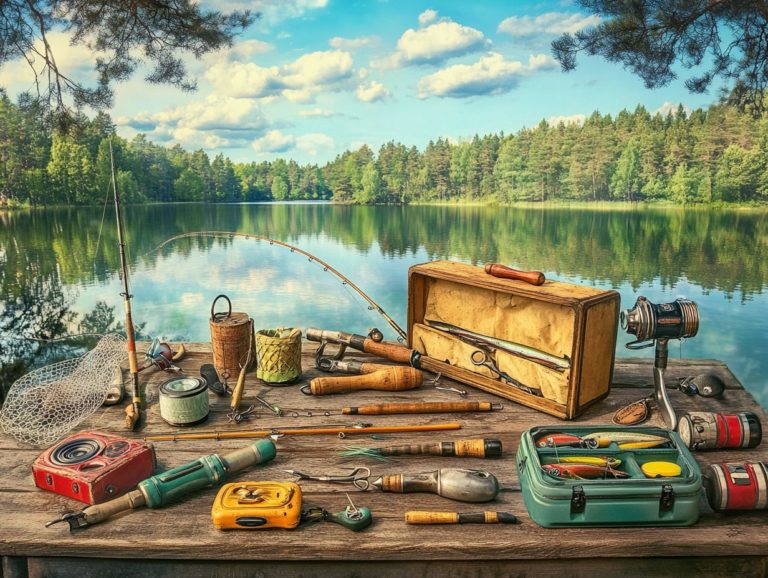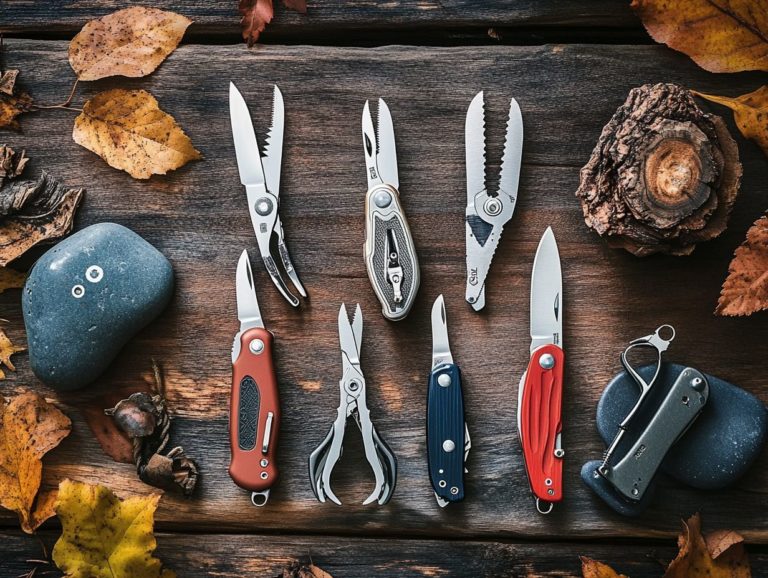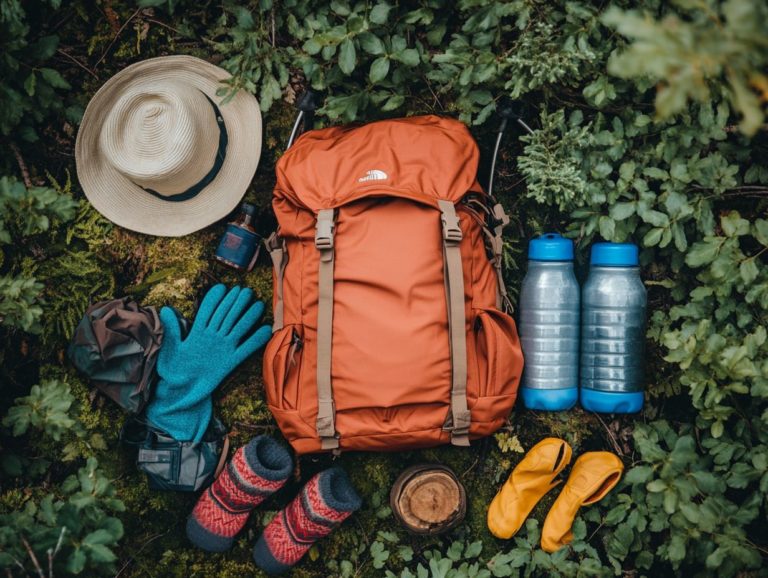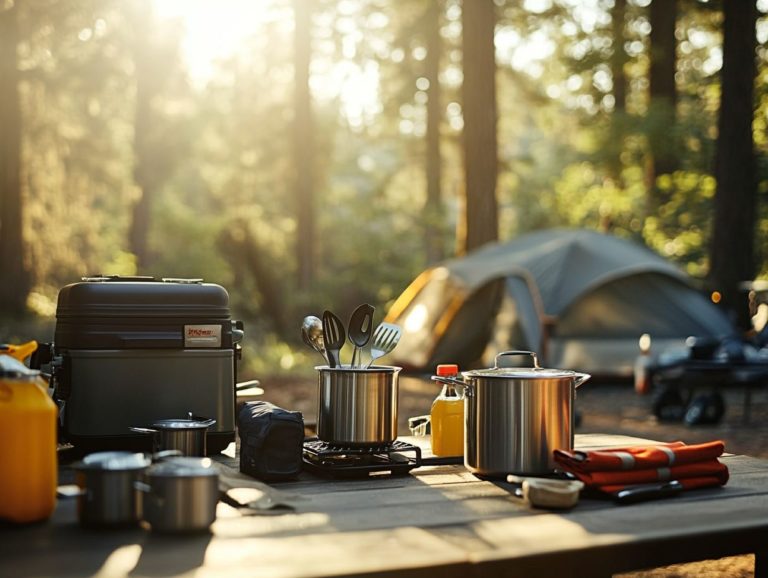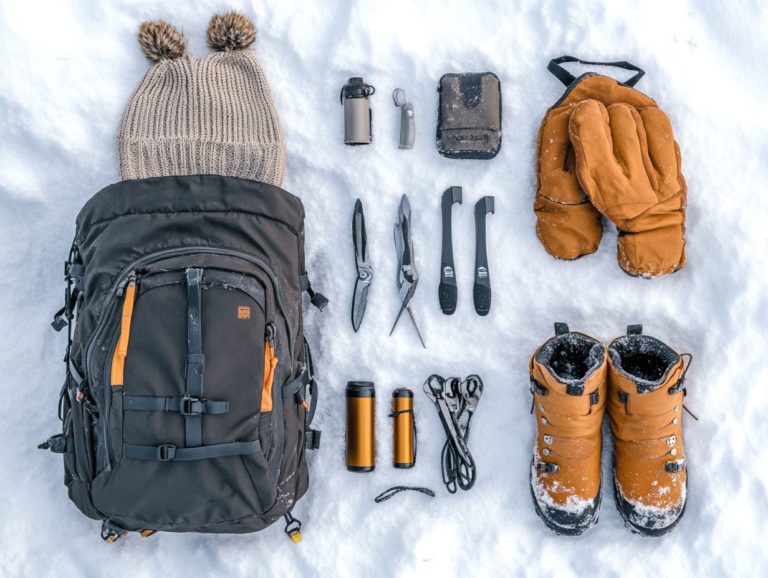The Best Accessories to Enhance Your Hiking Experience
Embarking on a hiking adventure can be exhilarating! The right gear can truly transform your experience.
Let s explore the must-have hiking accessories that will elevate your outdoor adventures, from robust backpacks and dependable boots to indispensable navigation tools and safety equipment.
Each item serves a crucial purpose in ensuring your comfort and readiness on the trail. Whether you’re an experienced hiker or just beginning your journey, discover how these accessories can enhance your adventure and keep you safe every step of the way.
Contents
- Key Takeaways:
- 1. Hiking Backpack
- 2. Hiking Boots
- 3. Trekking Poles
- 4. Water Bottle
- 5. Headlamp
- 6. Portable Charger
- 7. Navigation Tools
- 8. First Aid Kit
- 9. Rain Gear
- 10. Insect Repellent
- 11. Sun Protection
- 12. Multi-Tool
- 13. Portable Stove
- 14. Emergency Shelter
- 15. Camera or Binoculars
- What Are the Essential Accessories for Hiking?
- Frequently Asked Questions
- What are the must-have accessories for a better hiking experience?
- Why is a comfortable backpack important for hiking?
- What type of shoes should I wear for hiking?
- How can trekking poles enhance my hiking experience?
- Why is it important to carry a water bottle while hiking?
- What should be included in a first aid kit for hiking?
Key Takeaways:
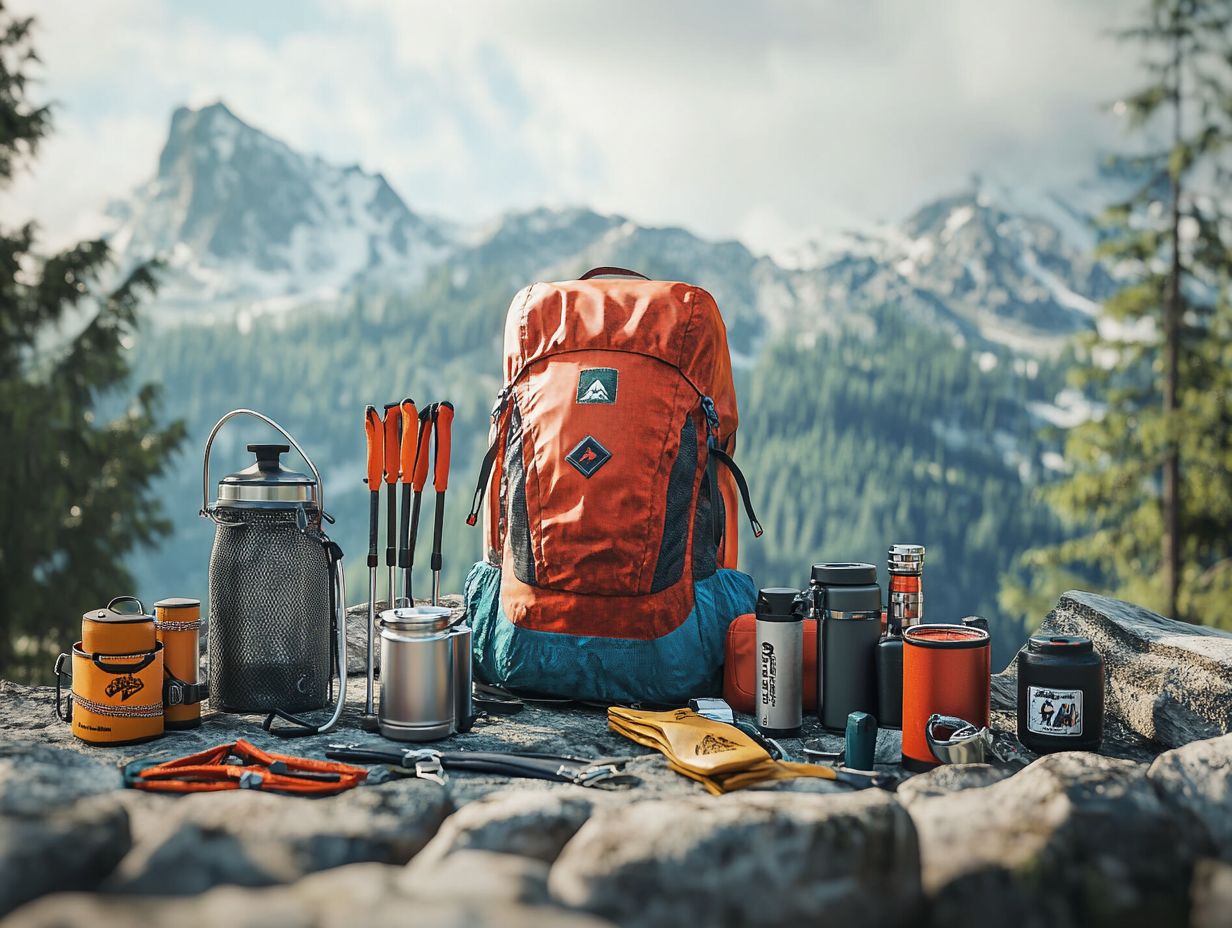
- A well-equipped hiking backpack helps you carry essential items comfortably.
- High-quality hiking boots provide support and protection for your feet.
- Trekking poles help balance your weight and reduce strain on joints.
1. Hiking Backpack
A high-quality hiking backpack is an essential part of your gear. It comfortably carries your vital equipment and supplies, whether you’re setting off on a day hike or planning an extended backcountry adventure.
Choosing the right backpack involves more than just looks; it s about finding the right balance between size, weight, and comfort. A well-fitted backpack can significantly reduce strain and fatigue on long treks. This allows you to immerse yourself in the breathtaking scenery instead of being distracted by discomfort.
Using compression straps straps that help hold your gear tightly and various compartments can improve your organization, making it easy to access what you need quickly. When considering top brands like Osprey, focus on features that align with your specific activities.
Efficient packing strategies such as placing heavier items closer to your back and using packing cubes for smaller essentials enhance stability and make your trek feel much more effortless.
2. Hiking Boots
Investing in a quality pair of hiking boots is crucial for comfort and safety on the trails. They provide the support and protection your feet need during long hikes.
With many options available, consider factors like waterproofing, grip, and ankle support when selecting the perfect footwear for your adventures. Waterproof hiking boots are essential for wet conditions and muddy trails, while boots with excellent grip are key for maintaining traction on uneven surfaces. Ankle support especially from mid-height boots offers invaluable stability and helps reduce the risk of sprains.
The right fit cannot be overstated; uncomfortable boots can lead to blisters and fatigue, which no one wants on a trek. Brands like Merrell, Salomon, and Columbia are known for their durable and reliable hiking footwear, making them ideal choices for exploring the great outdoors with confidence.
3. Trekking Poles
Trekking poles are critical tools that can enhance your hiking experience. They improve stability and alleviate strain on your legs during those challenging treks, making them worthy of a prime spot in your gear.
These lightweight companions offer remarkable benefits for outdoor enthusiasts. By improving your balance on uneven terrain and evenly distributing weight across your body, they help reduce fatigue, allowing you to enjoy longer, more rewarding hikes.
When selecting trekking poles, consider key factors such as adjustable height, weight, and grip material for a comfortable fit tailored to your needs.
For optimal use, plant the poles ahead of you to create a stable base. This technique assists you in both ascents and descents and minimizes stress on your knees, paving the way for a safer and more efficient hiking adventure.
Get ready for your next hike and make sure you have the best gear to enjoy every moment!
4. Water Bottle
Staying hydrated is crucial during hiking adventures. A reliable water bottle or hydration system like hydration packs or bladders can elevate your performance and well-being.
Proper hydration helps maintain your energy levels and supports your thinking ability. This enables you to navigate challenging terrains with greater ease.
When selecting a water bottle, you ll find a variety of options tailored to different needs. You might gravitate toward lightweight plastic bottles for convenience, or perhaps you prefer stainless steel alternatives for exceptional durability and insulation, keeping your drinks refreshingly cold for hours.
Portable water filters can be a game-changer, allowing you to safely source drinking water from natural streams and rivers. This alleviates the burden of carrying large amounts of water, ensuring you maintain a steady supply of hydration throughout your adventure.
5. Headlamp
A great headlamp is a must-have for every hiker! It ensures you can navigate trails safely after dark or in low-light conditions.
When considering a headlamp, pay close attention to brightness levels. Adjustable illumination allows you to tailor the light to suit various environments and tasks, providing optimal visibility without dazzling your fellow hikers.
Battery life is critical; a long-lasting battery can be the line between a successful hike and an unfortunate plunge into darkness.
Lightweight design is equally important, allowing for extended wear without unnecessary bulk or fatigue. By prioritizing these features, you not only enhance your overall hiking experience but also significantly improve your safety. This aids in spotting potential hazards and avoiding accidents on dimly lit paths.
6. Portable Charger
Don’t hit the trails without a portable charger! It’s an essential companion for hikers, especially when you rely on smartphone navigation and want to stay connected during outdoor adventures.
As you venture into unfamiliar terrains, the reliability of your devices becomes paramount for safety and enjoyment. In emergencies, being able to communicate or navigate back can be truly life-saving.
Capturing stunning vistas and candid moments along the trail adds to your experience, which requires a charged camera or smartphone. To meet these needs effectively, consider factors like battery capacity, weight, and weather resistance when selecting a portable charger.
Choose a model that offers fast charging and multiple output ports. This allows you to accommodate various devices and enjoy your hikes without hassle.
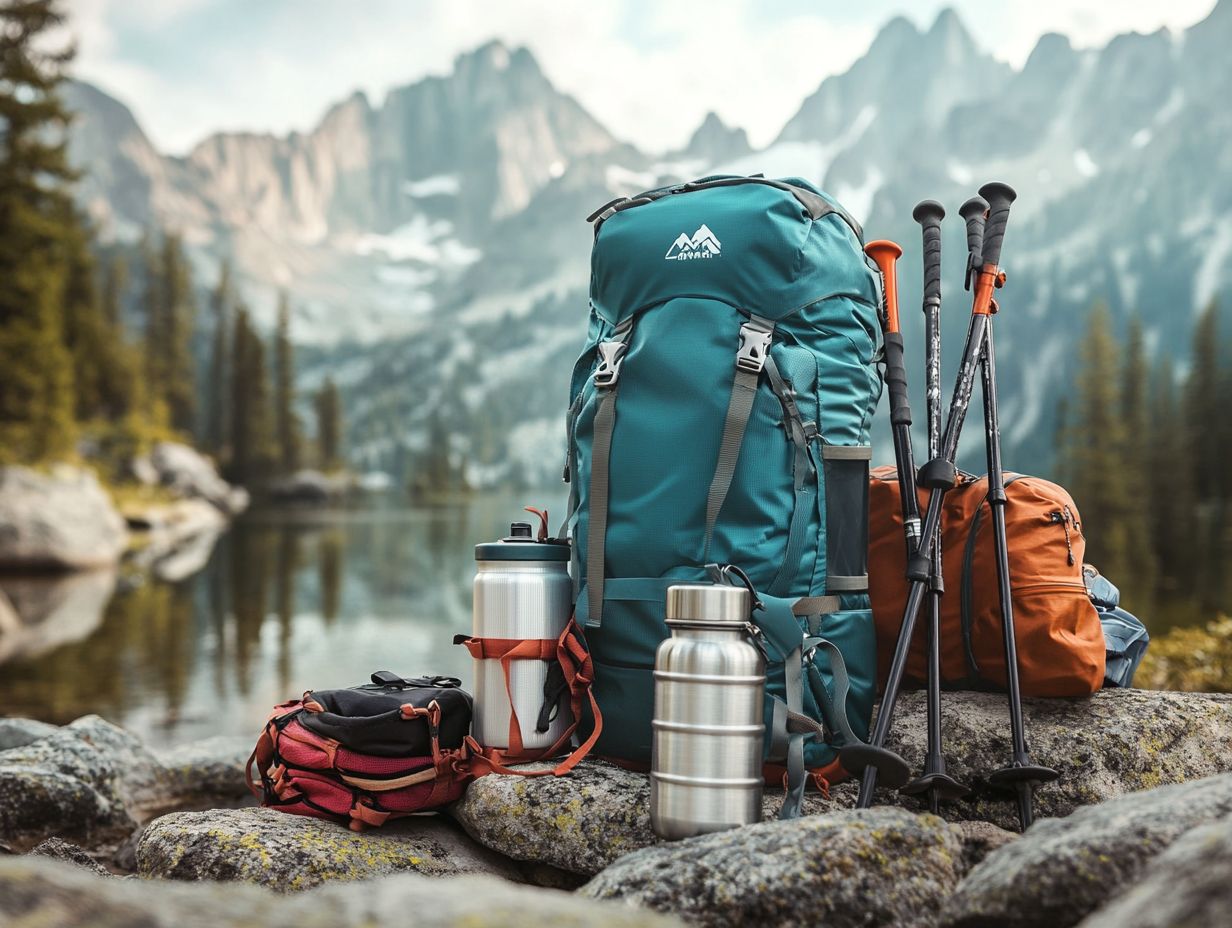
With the right navigation tools, every hike turns into an adventure waiting to happen! They provide critical information needed to explore trails safely and avoid getting lost whether you prefer smartphone navigation apps or traditional hiking maps.
Among popular choices, GPS devices like Garmin deliver reliable performance, even in remote areas. They allow you to track your routes accurately without relying on cell service.
Apps such as AllTrails and Gaia GPS have become favorites among outdoor enthusiasts for their user-friendly interfaces and extensive trail databases. These tools enable you to access detailed maps, user reviews, and real-time data, significantly enhancing your outdoor experience.
By utilizing these innovative navigation aids, you can confidently explore the wilderness, secure in the knowledge that you have a reliable means to find your way back safely.
8. First Aid Kit
A well-stocked first aid kit is a must-have for your hiking adventures. It allows you to tackle minor injuries and emergencies that may arise during your outdoor excursions.
Your kit should include various types of components tailored to the challenges you might face on the trail. Fundamental items like bandages will protect wounds from infection. Antiseptics will help you clean cuts, and gauze will dress deeper injuries.
Incorporating emergency tools such as scissors, tweezers, and a splint is invaluable for stabilizing injuries until professional help arrives. It’s crucial to understand the functions of each item. Knowing how to properly clean and bandage a wound can prevent complications. Familiarity with emergency procedures can truly make a difference in critical situations.
Taking the time to familiarize yourself with the contents of your kit will enhance your confidence and effectiveness when delivering first aid.
9. Rain Gear
Investing in high-quality rain gear, particularly a waterproof jacket, is essential for ensuring your comfort and dryness during unexpected weather shifts while hiking. This commitment to your gear guarantees both your safety and enjoyment on the trail.
A well-designed rain jacket comes with vital features like adjustable hoods, sealed seams, and ventilation flaps that enhance breathability a game-changer when tackling strenuous trails.
Don’t overlook the importance of waterproof pants; they typically boast elastic waistbands and zippers for effortless on-and-off access. This allows you to adapt swiftly to changing conditions. Choosing the right hiking essentials is key for maximizing your performance on the trail.
Modern materials like Gore-Tex and nylon blends not only repel water but also permit perspiration to escape, significantly improving your hiking experience. Ultimately, choosing the right rain gear empowers you to navigate through wet weather with confidence and ease. A lightweight backpack will help you carry all your gear comfortably.
10. Insect Repellent
Carrying insect repellent is essential to safeguard you from irritating bites and potential diseases that could tarnish your outdoor adventure.
You ll find a variety of insect repellents on the market, from natural oils like citronella and eucalyptus to synthetic options featuring DEET and Picaridin. DEET, a common insect repellent ingredient, helps keep bugs away. Each type offers different levels of effectiveness and duration of protection, so it s important to select one that aligns with the environment you plan to explore. Don’t forget to carry a water filter for safe hydration.
Follow the instructions for application diligently. Ensure you achieve even coverage on exposed skin and clothing. Prioritizing your safety is crucial; choose a product that s appropriate for your age and health conditions. This not only boosts your comfort but also keeps those pesky insects at bay. Immerse yourself in the beauty of nature without any unwelcome distractions.
11. Sun Protection
Sun protection is paramount for outdoor enthusiasts, and employing essentials such as sunscreen, hats, and breathable clothing can effectively shield your skin from harmful UV rays during your hikes.
Choose a broad-spectrum sunscreen with an SPF of at least 30. Diligently reapply every two hours especially after sweating or swimming to maintain its efficacy. Consider wearing UV-protective clothing, including long-sleeved shirts and wide-brimmed hats. These garments minimize direct sun exposure and enhance your comfort with moisture-wicking materials.
These precautions are crucial in preventing debilitating sunburn and heat exhaustion, which can quickly turn a delightful outdoor adventure into an uncomfortable experience. Having hiking clothes that provide both coverage and breathability can make a significant difference. Stay vigilant about sun safety prepare now to ensure your adventure is safe and enjoyable!
12. Multi-Tool
A multi-tool knife is an invaluable accessory for you as a hiker, offering a range of functions from emergency repairs to meal preparation.
When planning your hiking adventures, consider including a Nitecore headlamp for those low-light situations.
Beyond its primary role as a cutting tool, a quality multi-tool can feature pliers, screwdrivers, and even can openers, catering to the various needs that arise on the trail. When selecting the right multi-tool, consider factors like weight and size, as these will significantly influence how seamlessly it integrates into your hiking gear and works alongside other hiking equipment such as trekking poles.
Look for a model crafted from durable materials that can withstand rugged use. Ensure it includes features that align with your specific hiking style, whether you re planning extensive camping trips or quick day hikes.
Pay attention to how easily you can access a multi-tool’s functions when every second counts.
13. Portable Stove
A portable stove is an essential piece of camping gear that allows you to prepare hot meals, significantly enhancing the enjoyment and comfort of your outdoor adventure.
Whether you choose a compact canister stove, a more robust liquid fuel stove, or even a wood-burning option, each type comes with its unique features tailored to your cooking needs and preferences. Canister stoves are often favored for their ease of use and lightweight design, making them perfect for backpackers. On the other hand, liquid fuel stoves provide greater fuel versatility, making them suitable for longer treks.
Understanding the importance of proper food storage, such as using airtight containers, can help you prevent spoilage and avoid attracting unwanted wildlife. To cook efficiently outdoors, consider pre-chopping ingredients at home and using multi-functional tools. Opt for quick-cooking meals like lightweight pasta or dehydrated options. This way, you can whip up nourishing dishes without excessive hassle.
14. Emergency Shelter
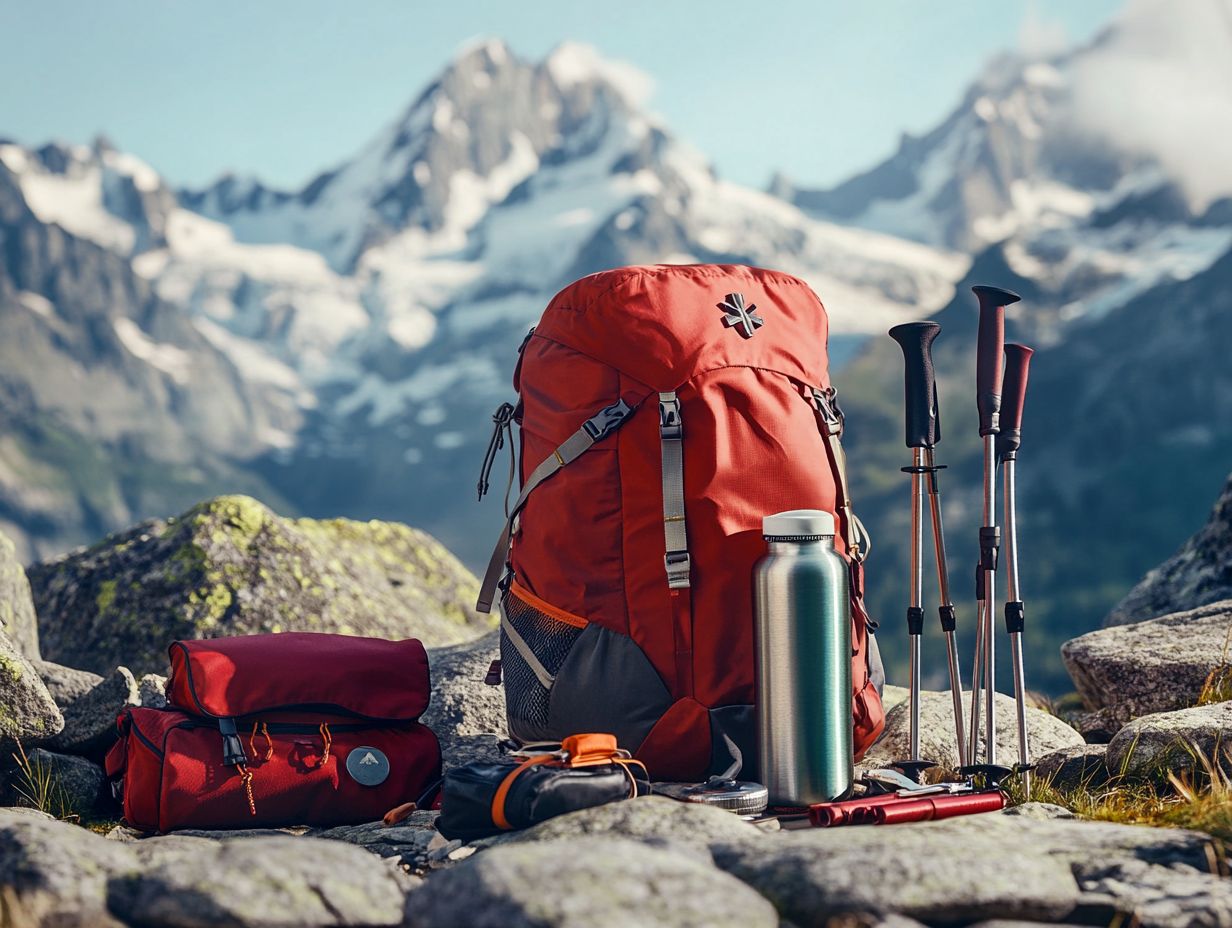
An emergency shelter, like a lightweight tent, can be a true lifesaver when the weather takes an unexpected turn or emergencies arise while you re out hiking. Don t wait until it s too late an emergency shelter can save your life!
These versatile shelters come in various forms, including bivvy bags (a small, waterproof cover for sleeping outdoors), tarps, and lightweight tents, each designed to meet specific needs and situations. A bivvy bag offers a compact and highly portable solution perfect for the minimalist adventurer who prioritizes weight and space. Conversely, a lightweight tent provides extra room and protection from the elements, making it an excellent choice for those who appreciate a touch of comfort.
By understanding these options and their advantages, you can significantly enhance your preparedness for outdoor excursions, boosting your chances of survival when faced with unpredictable conditions.
15. Camera or Binoculars
A camera or binoculars can truly elevate your hiking adventures, enabling you to capture breathtaking landscapes and observe wildlife in their natural habitats.
These tools not only give you the chance to freeze moments in time with stunning photographs, but they also encourage you to slow down and appreciate the intricate details of nature surrounding you. When traversing diverse terrains, a lightweight camera or compact binoculars can slide easily into any backpack pocket, ensuring you re well-prepared without the burden of excess weight.
If you’re after a simple yet effective solution, consider a compact point-and-shoot camera or a pair of high-quality, lightweight binoculars with excellent magnification. This way, you can effortlessly document your journey and spot vibrant bird species or distant mountain peaks, transforming every hike into a richer, more meaningful experience.
Embrace the beauty around you capture those unforgettable moments on your next hike!
What Are the Essential Accessories for Hiking?
Choosing the right hiking accessories is essential for elevating your outdoor experience. These items play a crucial role in your comfort, safety, and overall enjoyment on the trails. Important components include compression socks and hiking snacks to keep your energy levels up.
Consider durable footwear, designed to provide excellent traction on various terrains, or hydration systems that keep you refreshed during lengthy treks. Each accessory serves a specific purpose. A well-fitted backpack carries your essentials and distributes weight evenly, helping you avoid fatigue. Additionally, having the ultimate checklist for hiking gear can ensure you’re fully prepared for your adventure.
A first aid kit is important because it helps manage unforeseen accidents with ease. Likewise, navigation tools like compasses and GPS devices will keep you on track in unfamiliar territory. With the right gear, including a Garmin inReach Mini for navigation, you can transform a simple hike into a truly memorable adventure.
How Do These Accessories Enhance Your Hiking Experience?
The right hiking accessories, such as a durable backpack and an emergency kit, not only enhance your safety and comfort but also elevate your entire hiking experience. They allow you to immerse yourself in the beauty of nature without distractions.
A well-fitted backpack, like the Osprey Hikelite, evenly distributes weight, minimizing strain and enabling you to tackle long trails without discomfort. Don’t forget to check out the top hiking gear accessories you need. Quality footwear, equipped with cushioned soles and solid ankle support, protects you from injuries and fatigue, letting you navigate rocky terrains with confidence.
Trekking poles significantly enhance your stability on uneven surfaces, ensuring every step feels secure. Hydration packs do more than quench your thirst; they encourage a slower pace, inviting you to savor the landscape around you.
With these essential tools, you ll find yourself more attuned to the rustling leaves, the invigorating scent of pine, and the breathtaking vistas that surround you.
What Factors Should You Consider When Choosing Hiking Accessories?
When selecting hiking accessories, it s crucial to weigh factors such as weight, how well it works, and durability to ensure that your choices align seamlessly with your hiking style and specific needs.
Consider the type of hike you’re planning, whether it’s a leisurely stroll on well-marked trails or a challenging backcountry adventure. Weather conditions will also play a significant role in your gear selection. For instance, waterproof materials may be essential in rainy climates, while breathable fabrics are perfect for warmer days. To ensure you have everything you need, check out the best hiking gear for minimalists. Don’t overlook your personal preferences, such as comfort and looks.
When prioritizing essential gear, including hiking maps and smartphone navigation, evaluate these considerations: make sure to also check out the best gear for cross-country hiking.
- Start with pack essentials, like hydration systems and snacks.
- Follow up with attire suited to the environment.
- Finally, include any additional tools or gadgets that could elevate your overall experience.
Are There Any Accessories That Can Be Used for Multiple Purposes?
Many hiking accessories can serve multiple purposes, offering you both versatility and efficiency in packing, while enhancing your overall hiking experience.
Take, for example, a multi-tool knife. It slices through ropes and doubles as a screwdriver or bottle opener, making it a critical companion on the trail. Then there s the portable stove, which allows for quick meals and can transform into a coffee maker in the morning or even purify water when the need arises.
These multifunctional items reduce the need for extra gear, saving you valuable space and weight in your backpack. By embracing such ingenious tools, you can turn your outdoor adventure into a smoother, more enjoyable journey.
How Can You Properly Pack and Organize Your Hiking Accessories?
Packing and organizing your hiking accessories is key for efficiency. It helps you quickly find what you need during your adventures.
To organize better, categorize your gear into groups: clothing, navigation tools, first-aid supplies, and food. Use packing cubes or dry bags to create clear sections in your backpack.
Keep frequently used items like snacks and your water bottle at the top or in a side pocket. This way, you avoid the hassle of digging through your pack.
This approach improves your hiking experience and makes your journey safer and more enjoyable.
Frequently Asked Questions
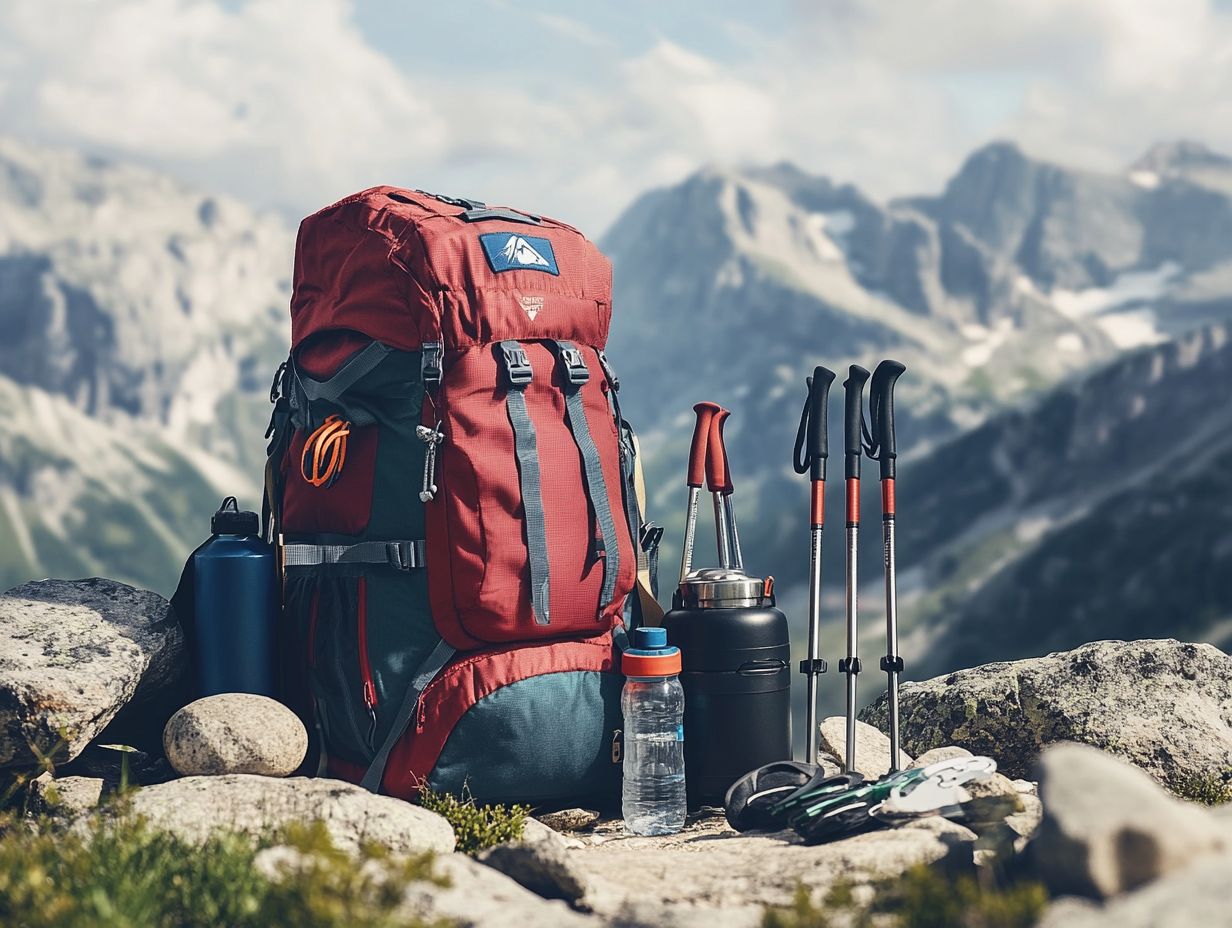
What are the must-have accessories for a better hiking experience?
The best accessories for hiking are a comfortable backpack, good hiking shoes, trekking poles, a water bottle, a map or GPS, and a first aid kit.
Why is a comfortable backpack important for hiking?
A comfortable backpack spreads the weight out. This reduces strain on your back and lets you pack everything you need.
What type of shoes should I wear for hiking?
Wear hiking shoes with good traction and ankle support. Avoid regular sneakers or sandals.
How can trekking poles enhance my hiking experience?
Trekking poles help you stay stable on uneven ground. They also reduce stress on your knees and can lower fatigue.
Why is it important to carry a water bottle while hiking?
Stay hydrated! Carrying a water bottle allows you to drink whenever needed. Dehydration can cause fatigue and dizziness.
What should be included in a first aid kit for hiking?
A hiking first aid kit should have bandages, antiseptic wipes, blister treatment, pain relievers, insect repellent, and any personal medications. It’s crucial to know how to use these items in an emergency.


